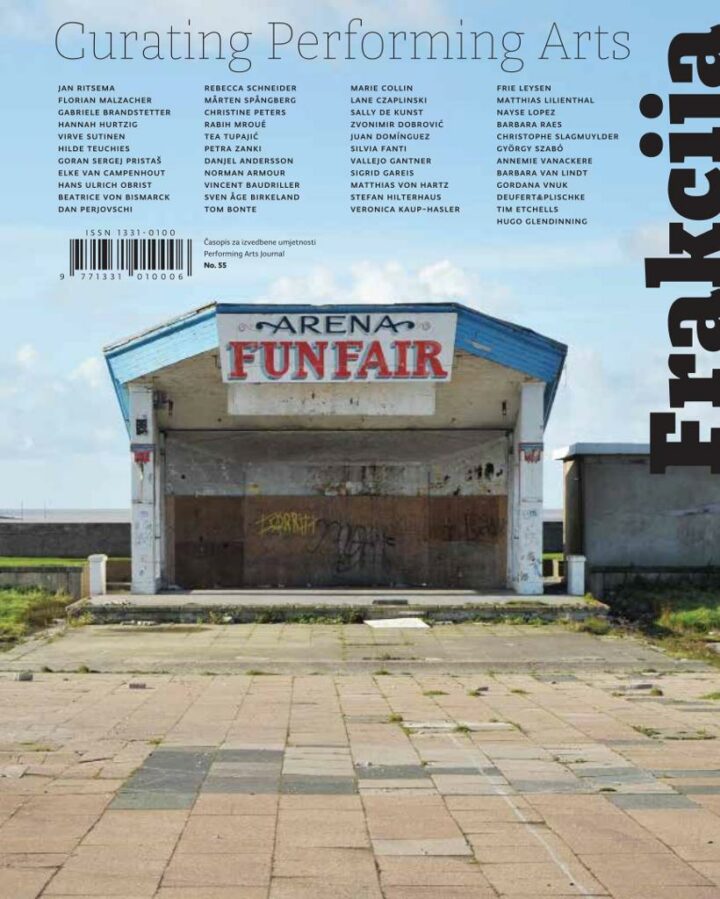The concept of performative curating stresses the two strands of the meaning of the term performative. As Shannon Jackson explained, the word on the one-hand underlines Austin’s, Butler’s and others’ notion of the reality-changing capacities of cultural utterances. On the other hand, it has also a more colloquial meaning, which refers to works and situations that are theatre-like but not theatre.16 While Jackson dismisses the latter as too literal, for me the appeal of the concept of performativity lies exactly in this double meaning. The reality-changing capacity as well as the use of techniques, methods, strategies and tactics of the performing arts. When we talk about theatre as assembly – a form that I am especially interested in – and then think of Judith Butler’s book on assembly and Occupy it becomes clear.17 While Butler is less interested in the theatricality of the movement, she still talks about the importance of bodies coming together enacting the phrase “We the People.” I would add that there are other very theatrical aspects of OWS, the human mic for example. At the same time, it was performative in the sense of reality-changing: it created a different way of being just by doing it. Occupy was less about the demands being put out, and more about the fact that as soon as you lived it, you were changing your own reality as well as the reality outside.
It might sound pretentious to talk about translating this to theatre or to curating. But still: When in the case of “Truth is Concrete” there is an audience together for 160 hours, their collectiveness changes – by spending time with each other, by being bodies next to bodies, by being bored or angry, by negotiating space and experiences etc. All these are means of curating and making theatre and performance, but we often do not put enough focus on this.
PE: What are the implications of performative curating for artistic practice? How will the presentation of performance practice or various types of festivals have to change ultimately? How should they change?
FM: There seems to be a fear that the role of the curator becomes too important, that she or he has too much influence on the artistic work. But first of all, production in theatre, dance, performance is comparably slow and already always a process of negotiation – the concept of commissioning for example is quite different from that within visual arts. For me curating means that vice versa the artist is getting into a conversation that shapes the context. It is about being able to think together. What I propose might imply giving up the power inherent to the notion of an autonomous artwork, but at the same time it is about gaining power by co-creating, curating together the context and the relations to other artists and artistic works. Ideally it is an exchange for developing something together. Sometimes this means inviting someone to work in a specific frame, asking if they would be interested. Sometimes, it means creating the context around a work. There are different levels of exchange and collaboration and being open to influence is key. In theatre we are used to that anyway. Theatre is full of compromises and it is always collaborative.
BF: Can you tell us about where your work is headed? What is your next project that you are excited about?
FM: At the moment I work as a freelance independent curator, which offers the opportunity to work on several projects at once. With Jonas Staal we did the first edition of a project called “Training for the Future” in September [2019], a three-day program of creating a training ground with many different practices from artistic and activist fields. Hopefully we will have another edition and continue working on that project. Another of my projects is going to happen in a small city close to Cologne where the father of Friedrich Engels had one of his factories. This town does not have much of a typical art audience, so it is an interesting challenge to foster together with the artists a conversation about the changing role of work. And I was just working with Lola Arias as a dramaturg and now in a project by Tania Bruguera – you can imagine they have very different approaches and demand very different ways of collaborating! I also just finished writing a book on political theater…
There is an advantage to not being involved in running a larger organization. The work can often be more precise and have a bigger variety. On the other hand, I am still interested in being part of a festival or venue – the work within institutions is often frustrating but also very important. For me it is still interesting to witness how a venue, or a festival can be influenced by the concept of performative curating. We need to challenge the performative potential of institutions while at the same time protect them in a time where more and ore of them are under political and economic threat.
